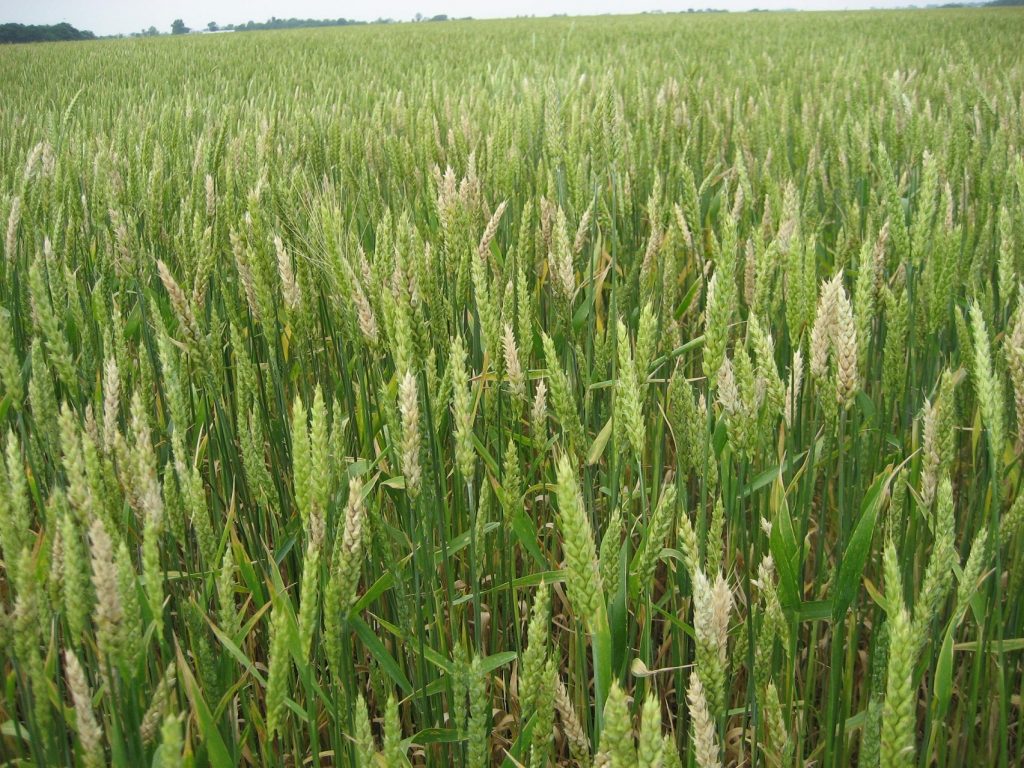Conditions favorable for Fusarium head blight (scab) in southern Illinois
Wheat plants are now beginning to head out and flower in parts of southern Illinois. During this critical time of wheat development, wheat becomes susceptible to infection by Fusarium graminearum, the causal agent of Fusarium head blight (FHB; also known as scab) (Fig. 1). This disease can cause reduced grain yield, test weight, and quality. In addition, the fungus can produce toxins that will contaminate grain such as deoxynivalenol (DON; also known as vomitoxin). Harvested grain with high levels of DON may be discounted or outright rejected at the elevator. To achieve the best management of FHB, different management practices must be implemented, such as planting wheat into fields that were previously cropped to soybean (rather than corn), planting wheat varieties with moderate to high levels of resistance to FHB, and applying foliar fungicides at the proper timing. Of these different management practices, the application of foliar fungicides is the only one that can be done during the growing season and is the main focus of this article.

Multiple fungicides are registered for use on wheat, but only a few have efficacy in managing FHB. Fungicides available for FHB management all belong to the triazole class of fungicides and are Caramba (BASF Corporation), Prosaro (Bayer CropScience), Proline (Bayer CropScience), and products that contain tebuconazole as their solo active ingredient. Of these products, the best efficacy has been obtained with Prosaro and Caramba in multi-state university field research trials. Proper fungicide application timing is critical in achieving the best efficacy. The best application timing is considered to be when plants are beginning to flower (early anthesis – Feekes growth stage 10.5.1), but some efficacy may still be achieved slightly before or after Feekes 10.5.1 (Table 1). In regards to fungicide application timing, it is important to always follow the label recommendations and consider the preharvest interval (PHI) requirements (PHI for Caramba, Prosaro, Proline, and tebuconazole products is 30 days). Fungicide products that contain strobilurin active ingredients are not labeled for control of FHB, and in multiple university research trials, strobilurin fungicides have been shown to increase DON levels in grain compared to non-treated checks. Therefore, it is extremely important that only effective triazole fungicides be applied for management of FHB.
Table 1. Effect of fungicide application timing on Fusarium head blight (FHB) control in wheat. Results represent data collected from Dixon Springs, IL in 2009, and Brownstown, IL, Carbondale, IL, Dixon Springs, IL, and Urbana, IL in 2010 (University of Illinois and Southern Illinois University trials funded by the U.S. Wheat & Barley Scab Initiative).
| Fungicide | Application timing | FHB (% control)* |
| Prosaro @ 6.5 fl oz | Feekes 10.5 | 35 b |
| Feekes 10.5.1 | 59 a | |
| 5 days after Feekes 10.5.1 | 37 b | |
| Caramba @ 13.5 fl oz | Feekes 10.5 | 38 b |
| Feekes 10.5.1 | 61 a | |
| 5 days after Feekes 10.5.1 | 36 b |
*Values followed by the same letter are not significantly different with 95% confidence.
When making a decision on if a fungicide application is needed, FHB risk should be assessed. A FHB Prediction Tool is available on-line at www.wheatscab.psu.edu. This risk is based on weather conducive for FHB, and should be assessed for each field as they begin to develop heads in anticipation of flowering. On May 9, 2013, a medium to high risk of FHB was present in parts of southern Illinois where wheat may be flowering already or will be in the next few days (Fig. 2). For fields that have not yet begun to flower, continued monitoring of the FHB Risk Prediction Tool is recommended.






